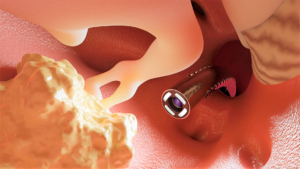Home » Supported Research » Transnasal diagnosis of middle ear disease
Transnasal diagnosis of middle ear disease
Title:
Transnasal diagnosis of middle ear disease
Project Number:
5R21DC016153-02
Contact PI/Project Lead:
Robert Webster
Award Organization:
National Institutes of Health
Abstract:
The objective of this proposal is to replace exploratory surgery with a novel natural-orifice approach to diagnose and surveil middle ear disease. Middle ear disease is one of the most prevalent worldwide disorders (1 in 50 people suffer from it at any given given time [1]), and definitive diagnosis often requires cutting the eardrum for visual inspection thought the ear canal. We propose a new ultra-thin endoscope that passes through the patient’s nose and then through the Eustachian tube to reach the middle ear. This ultra-thin endoscope will have pan and tilt degrees of freedom at its tip to facilitate comprehensive visual inspection of the middle ear for diagnosis and monitoring of the healing process after surgery. This device is innovative because nearly all prior flexible endoscopes are too large in diameter to pass through the Eustachian Tube. The ones that are sufficiently small lack a suitable bending tip, which is needed to inspect the interior surface of the middle ear [2, 3]. We solve this problem using a novel Nitinol-based approach where material is selectively removed to adjust the asymmetric elasticity of the endoscope tip. This enables novel curved tip shapes to be created via a single pull-wire, enabling the device to be extremely thin. We will create and validate this device via three Specific Aims. Aim 1 involves the design, fabrication and testing of our novel endoscope tip design. In Aim 2 we use a computer model of inner ear geometry to optimize endoscope parameters. Aim 3 addresses validation of the endoscope prototype in cadaveric specimens. The endpoint of this R21 will be proof-of-principle for our ultra-thin endoscope concept, together with a cadaveric demonstration of non-invasive trans-nasal middle ear inspection.
